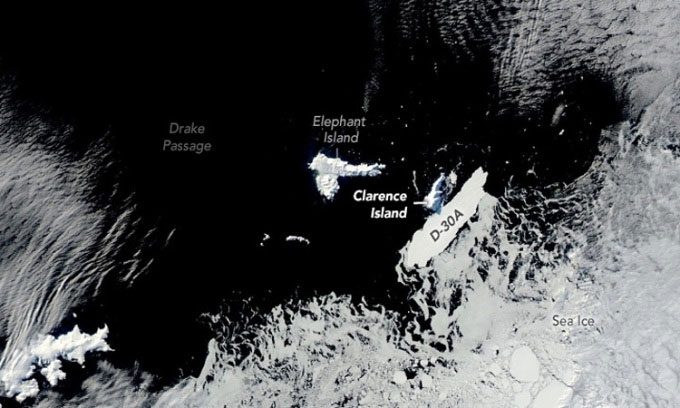The iceberg D-30A collided with Clarence Island, which is the breeding ground for 100,000 pairs of macaroni penguins, but fortunately, they were out foraging at the time.

Satellite captures the collision between D-30A and Clarence Island. (Photo: NASA).
On September 6, a massive iceberg, about half the size of Rhode Island, crashed into a penguin sanctuary in Antarctica, two years after a similar incident in 2021. The giant iceberg named D-30A measures 72 km long and 20 km wide. It is the largest remaining piece of D-30, which was formed in June 2021 when the parent iceberg D-28 collided with an island near the Borchgrevink Ice Shelf in East Antarctica and split in two. Since then, D-30A has been slowly drifting west along the Antarctic coastline.
At the end of 2022, D-30A suddenly changed direction and headed straight for Clarence Island in the eastern part of the South Shetland Islands, which has a surface area about ten times smaller than D-30A. On September 6, the iceberg struck the southern coastline of the island before rotating eastward and moving out to sea a few days later, according to NASA’s Earth Observatory.
Clarence Island is a crucial breeding site for macaroni penguins (Pygoscelis antarcticus), with around 100,000 pairs visiting the island each winter to lay and incubate their eggs. Researchers are concerned that the iceberg could impact this penguin population. “It’s fortunate that the macaroni penguins were not at their nests when this occurred,” remarked Heather Lynch, a statistical ecologist at Stony Brook University in New York. “If the collision had happened more than two months later, when the penguin colony was on the island, the situation could have been very serious.”
Collisions between icebergs and islands can harm wildlife, especially if they become trapped on the seafloor around the isolated land. Icebergs can prevent animals from swimming out to sea to forage, while also altering the temperature and salinity of the surrounding seawater. As the ice melts along the seafloor, it can destroy ecosystems and severely disrupt the local food web. The seabed around Clarence Island may help mitigate the disaster due to its depth, making it less likely for D-30A to become trapped there, according to Christopher Shuman, a glaciologist at NASA’s Glaciology Science Laboratory and the University of Maryland.
However, even if the iceberg does not become stuck for an extended period, it can still pose real problems for the nesting penguins on the island. While incubating eggs, penguins wait for their partners to return from foraging. A few days of blocked access to their colony can lead to a failed breeding year. Nevertheless, as D-30A drifts past the island, it may release iron-rich meltwater, supporting the growth of algae in the area.
Currently, D-30A is heading towards the Drake Passage, where large icebergs are often swept into currents, pulling them into warmer waters where they gradually melt. In November 2022, the world’s largest iceberg, previously known as A-76A, was also observed on a similar trajectory before breaking apart in June of this year.


















































